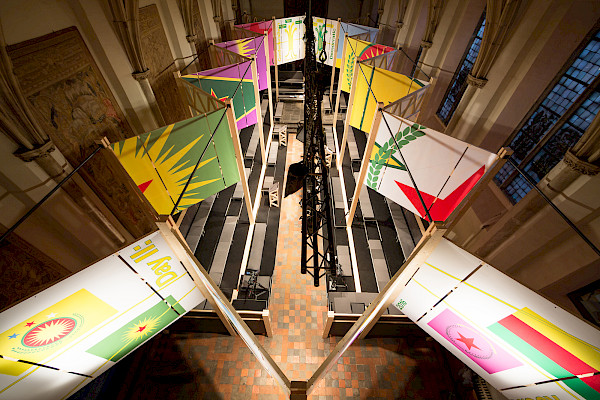
Jonas Staal, New World Summit – Utrecht (2016)
BAK, basis voor actuele kunst, Utrecht, i.s.m. Universiteit Utrecht.
Foto: Nieuwe Beeldenmakers
An influential art historian once said that exhaustion is the reason every avant-garde eventually comes to an end. An irrevocable end, not to be recuperated in some neo-this or neo-that. He was referring to art movements, but what about art institutions or the people who work there?
That statement brought back a second memory, namely that, in the 1970s, art historians had advocated for a reappraisal of the “late Picasso,” at a time when artists’ careers were still commonly understood in terms of rise, peak and decline. This memory resurfaced when, at the end of June, a small group gathered to bid farewell to Maria Hlavajová as director of BAK Utrecht. It was not a cheerful farewell, as insufficient financial resources and support had made it impossible for the institution to continue as wished.
After a short period of relative calm in the art world, things have once again become unsettled, with various art institutions now under threat; for some, the axe has already fallen. Nothing new, but why this feeling of deep unrest? Is it prompted by reports of employees reaching the end of their rope, due to internal problems? No doubt this exhaustion is also linked to a significantly changed attitude towards the sector ‘thanks to’ State Secretary Halbe Zijlstra more than a decade ago and the lasting impact of the budget cuts implemented by him — an episode brought back into focus by the policy of the most recent government. Another reason might be that such issues are made public and put under scrutiny faster than ever before. That’s what one calls transparency. No one could possibly be against it. However it’s the kind of transparency we associate with tabloids and social media, with the result that the picture comes first, the opinion second, and the cloudy facts at the end. The Dutch (and French) expression ‘aan het eind van je Latijn zijn’ [being at the end of your Latin] comes to mind — that points not only to physical and mental exhaustion, but also to a failure to meet expectations and resigning yourself that the endgame – the decline – is near. Exhaustion reaches then obsolescence, the word commonly used when the relevance of art, artists, and art movements declines.
The specific quality of Dutch cultural policy – since statesman Thorbecke – has also proven to be its Achilles’ heel. While the government on the one hand seemed to follow its guiding principle — namely that it should refrain from making artistic judgments — it simultaneously, luckily enough, encouraged experimentation and often prioritized innovation. What’s wrong with that? The sting is: prioritized over what, exactly? It seems that the balance has been lost for some time now. Museums are producing exhibitions at a rapid pace, with a large portion of the budget going toward design and marketing, while other responsibilities are neglected. Entire departments, such as libraries, are cut or severely neglected. Research into their own exhibition and collection histories is scarce and barely accessible to the public. Cultural heritage may be a valued category, much of it got lost in the museums driven by aspirations like relevance, topicality and renewal. Although BAK Utrecht is not a museum, over the past twenty-five years it has grown into an established institution, tackling urgent issues and gaining a strong international reputation. Its strength had lain in an abundance of ambition. Has its agenda become exhausted or obsolete? If does not so, so what is the reason then of placing it on the chopping block? Here, exhaustion seems to have played a role in more than one sense. First of all the financial constraints, after a loss of persuasive power toward government bodies and secondly the exhaustion of people within the organization, especially those who wanted to contribute on a grand scale, but couldn’t keep it up.
It’s a trend we’ve seen in several museums in recent years, where directors are increasingly singled out as responsible for toxic work environments and the burnout of staff. Calling out individuals certainly has its merits, but both the more structural conditions and the prehistory that contribute to these issues, and the role of the supervisory boards often remain obscured. The conclusion is that the cultural sector in the Netherlands has become overstressed — due to overproduction, the fear of missing out or failing to capture the spirit of the times and the feeling that there is not enough focus on and time left for core responsibilities.